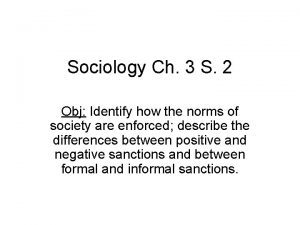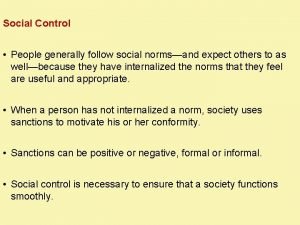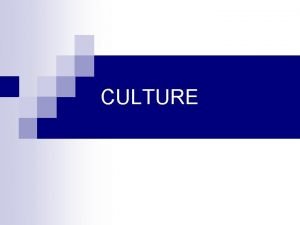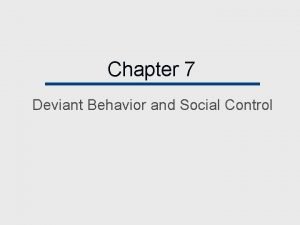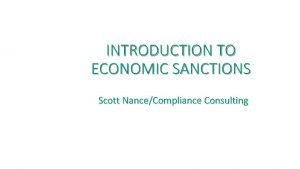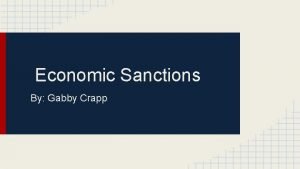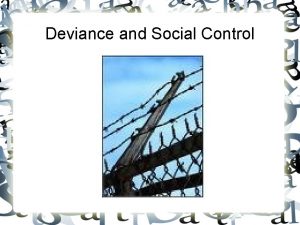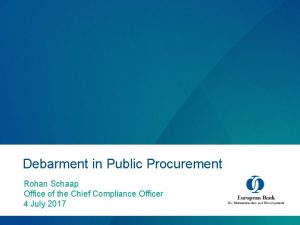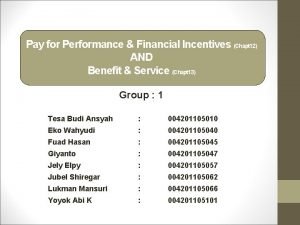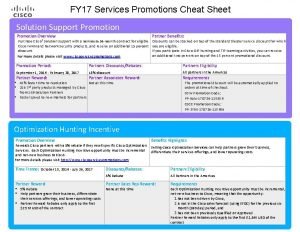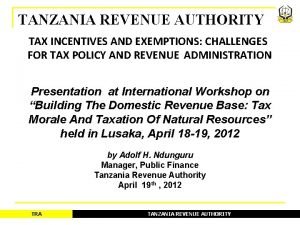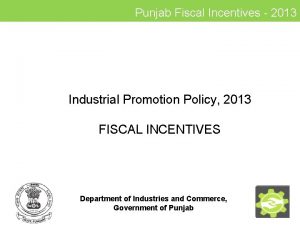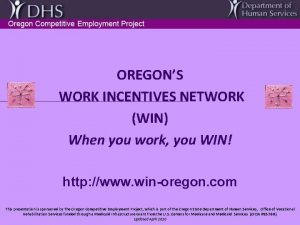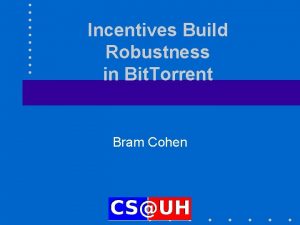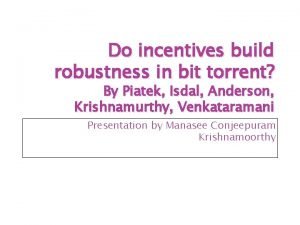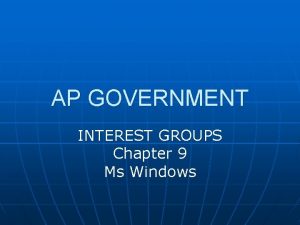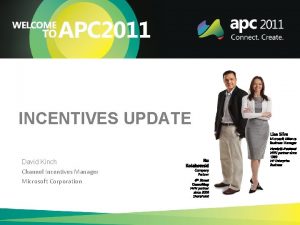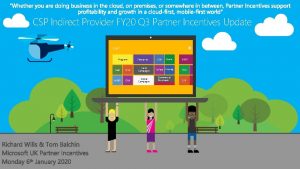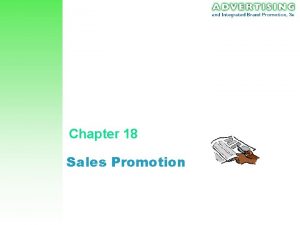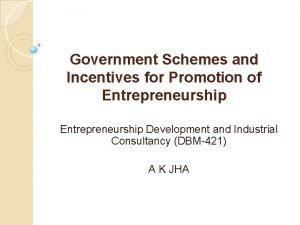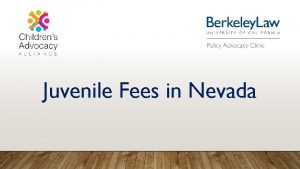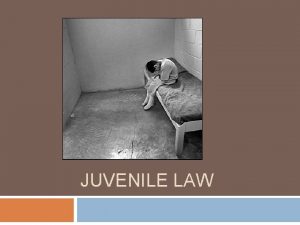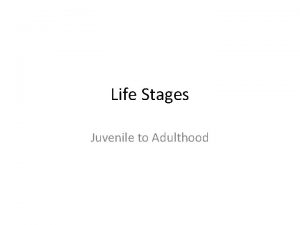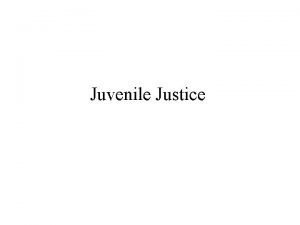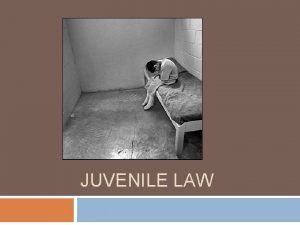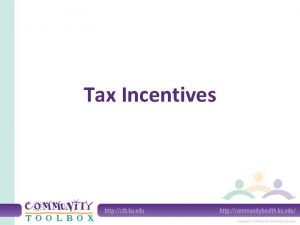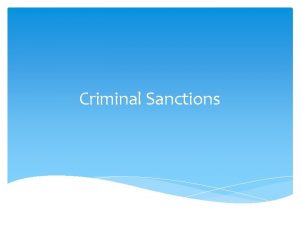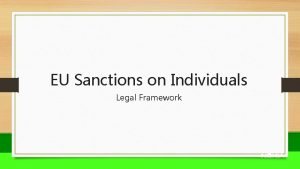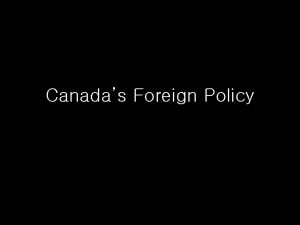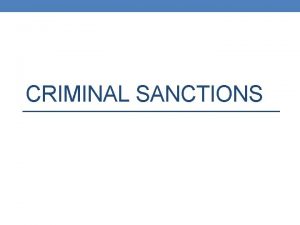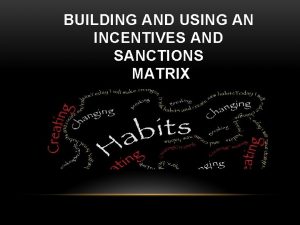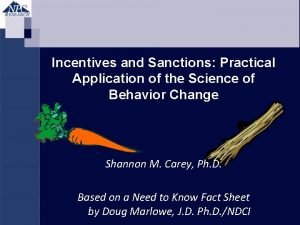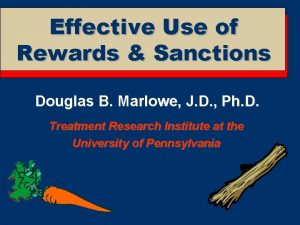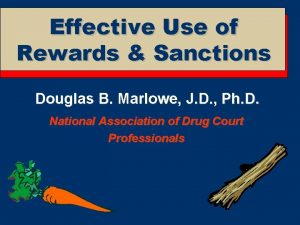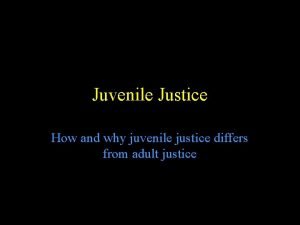Effective Use of Incentives and Sanctions in Juvenile



































- Slides: 35

Effective Use of Incentives and Sanctions in Juvenile Drug Court Jacqueline van Wormer, Ph. D. Washington State University S

This I Believe I believe juvenile drug court teams and professionals are strengthened, enlightened, and reinvigorated when I provide valuable training, technical assistance, and resources, which improves their knowledge level and adherence to the preferred model, which, in turn, may increase positive outcomes for youth and families in their community.

Learning Objectives S Participants will review and discuss proper phase structuring for adolescents – and why this matters in the proper use of incentives and sanctions. S Participants will learn about what DOES and what DOES work to promote positive behavior change in youth. S Participants will learn about contingency management for adolescent’s substance abuse and use. S Participants will learn how about contingency management theories and they work in juvenile drug courts. S Participants will learn how to develop behavior and activity contracts.

Are juvenile drug courts effective? Yes! But not always…. Depends on how (and if) they implement the model 4

Are juvenile drug courts effective? S Early research: S Small samples and poor designs. S Negative effects found by Hartmann & Rhineberger (2003); S No effects on recidivism found by Wright and Clymer (2001); Anspach et al. , (2003) S Positive Findings: S Lutze & Mason (2007); Latessa et al (2002), Rodriguez & Webb (2004), Shaffer et al. , (2008) Hickert (2010), Hennegeler (2006, 2012), NPC Research (2006, 2010) S Latessa report (2013) S Meta-Analysis: S Null-findings for both Wilson et al (2006); Shaffer

Taking a Closer Look CC BC HC SMC AA $9, 070 $8, 762 $5, 702 $2, 962 -172 357/29 407/26 283/12 341/13 315/40 2 weeks 3 weeks 4 weeks weekly Drug Tests 71 37 55 34 Self pay Family Counseling Yes No No Self pay Parenting Yes No No Youth and parent Youth Gender Specific + MH Youth Self pay Savings Court Sessions Treatment

Part I Building a Responsive Phase Structure S

Can We Strengthen Our Court Sessions to Bring About Stronger Behavior Change? S What is the purpose of using sanctions in your JDC? S What is the purpose of using incentives in your JDC? S What do youth behaviors look like during phase one? S How do you want them to look by phase four?

Frustrating Behaviors

It begins with the phase structure Phase Two Phase One Phase Three Phase requirements for youth and family should start out small, increase, and then decrease again after the youth work through treatment and court related goals.

Phase Structure Phase I: setting Phase. Source: II: Betty Gurnell Phase III: the stage learning skills maintaining the change Readiness and engagement Involvement, stabilization Reflection, enrichment Focus on compliance Beyond compliance Maintain drug testing, court appearance High level of structure Skill development Expanded development activities Clarifying expectations, building trust Completing assignments Enriching community connections

The Four Steps S Behavior to target S Current behavior S Desired behavior S Small, achievable increments

Decision Matrix – Phase I Incentives Sanctions Behavior *Response Attend school at least 18 out of 20 days • Teacher signs attendance card each day present and acknowledges • Small prize or coupon for each week with no absences • After school study hall for each day absent over the limit to make up all missed work

Decision Matrix – Phase II Behavior Attend regularly Complete all assignments Incentives Sanctions *Response • Select a book , notebook, pen after two weeks of success • Praise from teacher, family, court • Grades improve • After school study hall to complete assignments (with help as needed)

Decision Matrix – Phase III Incentives Sanctions Behavior *Response Attend regularly Complete all assignments Improve grades • Praise from teacher, family, court for improvement • Certificate of achievement • Select school related gift: tuition, book • Determine if tutor is needed • Attend extra class or session for help • Tighten curfew

7 (Easy) Steps to Individualizing Your Juvenile Drug Court Start with… 1. Screening and assessment And 2. Use the results to drive case planning So we can… 3. Emphasize individualized responses over generic, pre. Which should help us… 4. Work with youth and families to inform the process And 5. Focus on strengths And 6. Create lasting educational linkages And 7. Develop individualized incentives and sanctions determined requirements

Part II Incentives and Sanctions S

Goal-Oriented Incentives and Sanctions S Strategy Fifteen: “Respond to compliance and noncompliance with incentives and sanctions that are designed to reinforce or modify the behavior of youth and their families” S Research: S Gendreau (1999) S NPC (2006, 2010) S Henggeler et al. , (2006, 2012 (a) (b)) S Salvatore et al. , (2010)

Why We Want to Use Alternatives Probation/court monitoring, group homes, and correctional facilities have, at best, only modest favorable effects on subsequent recidivism. Some studies show negative effects (Lipsey and Cullen, 2007; Petrosino, Turpin-Petrosino, and Guckenburg, 2010).

Why We Want to Use Alternatives Deterrence-oriented programs that focus on discipline, surveillance, or threat of punitive consequences (e. g. , prison visitation Scared Straight–type programs, boot camps, and intensive probation supervision) have no effect on recidivism and may actually increase it (Lipsey, 2009).

Because… “Therapeutic” programs oriented toward facilitating constructive behavior change have shown very positive effects—even for serious offenders (Lipsey, 2009; Lipsey and Cullen, 2007; Lipsey and Wilson, 1998).

Reasons Why JDCs Should Implement CM S Theories are based on cognitive behavioral therapy, which has been proven to work with adolescents, and is vastly used in outpatient settings S It can be easily adapted within the JDC S In their study of six juvenile drug courts, Henggeler et al (2006) found stronger outcomes for those youth who received MST AND CM then standard process

Can We Strengthen Our Court Sessions to Bring About Stronger Behavior Change? S What is the purpose of using sanctions in your JDC? S What is the purpose of using incentives in your JDC? S What do youth behaviors look like during phase one? S How do you want them to look by phase four?

Incentives & Sanctions, Continued S Historical CJ responses vs. modification of behavior through a coordinated and thoughtful (research informed) process S Punishment for a “wrong” is not the goal – behavior change is the goal S The JDC should use a balance of incentives, sanctions and treatment responses

Incentives and Sanctions, continued S Key components: S Immediate, certain, fair and of appropriate intensity S Do not rely solely on standardized “lists” S Should be proportional and balanced S Punishment alone is least effective way to change behavior S Be comfortable in combining incentives and sanctions S Be cognizant of time S Perceptions of fairness – it all begins with individualization S Make sure youth understand their positive and negative reinforcers

Contingency Management So how do we strengthen the use of CM in our treatment settings, and utilize the same methods within our Juvenile Drug Courts?

Point & Level Reward Systems S Contract S Reward Menu S 3 for 3 S Most Valued Privilege S Checkbook System

Most Valued Privilege S This is a privilege that the youth values and will work hard to earn S Work with the youth and family to determine what the MVP is, preferably a family-based reward (i. e. , video games, cell phone use, time w/ friends) S The MVP is given or taken away with each drug screen S IMPORTANT – youth does not earn points if there is a positive drug screen but points that have already been earned are not taken away (Henggeler et al, p. 107 -108)

Make it Transparent MVP Sally – Use of cell phone John – Curfew extension on Saturday night Mary – Allowed to use Mom’s car on Friday afternoon Jack – Ride to school, rather than walk

Checkbook System S Basic checkbook set up – date; transaction description; debit/credit; and balance S Basic personal checks that the youth can draft and use to purchase items on the reward menu S Make this very visual and tangible for the youth S Consider working with a local bank to provide life skills training on how to keep a checking account and write checks or to provide free checkbooks and/or personalized checks (Henggeler et al, p. 126 -127)

3 for 3 Program 2. Bring JTDC Notebook 1. Pass all UAs 3. Make all appointments / contacts with case manager

Behavior Contracts S “Rewards for Responsible Behavior in Other Domains” (Henggeler et al, p. 131) S How to target specific behaviors (i. e. , school attendance) S How to add a step-by-step process for the youth to follow S How to get youth working towards “things” they are interested in S How to engage families/guardians in the process S How to increase communication between the youth and judge S And…how to implement these components in your

Behavioral Contract Example Goal Behaviors/ Tasks Enroll in GED • Call or visit program GED center by xxxxx date Incentives Noncompliance • Praise Failure to • Recognition contact by from Team XXXX • Appointment Calendar • XXXXXX Sanction • Increased reporting to PO • Increase in curfew • EM

Recommended Reading S Contingency Management for Adolescent Substance Abuse: A Practitioner’s Guide, by: Scott W. Henggeler, Phillippe B. Cunningham, Melisa D. Rowland, Sonja K. Schoenwald and Associates S Making Sense of Incentives and Sanctions in working with the Substance-Abusing Youth: Answers to Frequently Asked Questions (Juvenile & Family Justice TODAY. 2012, Volume 21, Number 2) S Enhancing the Effectiveness of Juvenile Drug Courts by Integrating Evidence-Based Practices (Journal of Consulting and Clinical Psychology. 2012, Vol. 80, No. 2, 264 -275)

Contact Information Jacqueline van Wormer, Ph. D. Washington State University SAC 403 A Spokane, WA (509) 628 -2663 (cell) jvanwormer@wsu. edu jgvanwormer@gmail. com
 Positive sanctions sociology
Positive sanctions sociology Formal negative sanctions examples
Formal negative sanctions examples Social control theory definition
Social control theory definition Latipso definition
Latipso definition What is the purpose of intermediate sanctions
What is the purpose of intermediate sanctions Formal negative sanctions examples
Formal negative sanctions examples Sanctions examples
Sanctions examples What are sanctions
What are sanctions Types of social control
Types of social control Sanctions training slides
Sanctions training slides Mdb sanctions
Mdb sanctions Contoh pay for performance
Contoh pay for performance Meetings incentives conventions and exhibitions (mice)
Meetings incentives conventions and exhibitions (mice) Cisco incentives and promotions
Cisco incentives and promotions Maritime energy conservation
Maritime energy conservation Tax incentives in tanzania
Tax incentives in tanzania Types of sales promotion
Types of sales promotion Fiscal incentives for industrial promotion (revised)-2013
Fiscal incentives for industrial promotion (revised)-2013 Work incentives network oregon
Work incentives network oregon Safeco spin to win
Safeco spin to win Dell partner incentives
Dell partner incentives Trade marketing plan ppt
Trade marketing plan ppt Microsoft partner incentive program
Microsoft partner incentive program Incentives build robustness in bittorrent
Incentives build robustness in bittorrent Tft
Tft Office 365 incentives
Office 365 incentives Solidary incentives definition ap gov
Solidary incentives definition ap gov External incentives
External incentives Office 365 incentives
Office 365 incentives Microsoft azure channel incentive
Microsoft azure channel incentive Microsoft managed reseller incentive
Microsoft managed reseller incentive Csp indirect reseller incentives
Csp indirect reseller incentives Price off deals sales promotion
Price off deals sales promotion Ntative
Ntative Government incentives for entrepreneurship
Government incentives for entrepreneurship April ford incentives
April ford incentives
